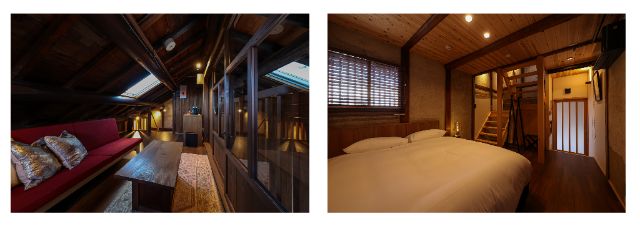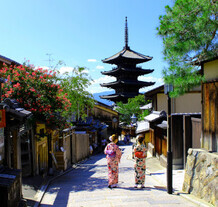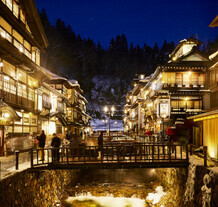.jpg)
The Tawaramoto area has an especially old history, even among Nara towns. This land, which expands at the foot of Mt. Miwa, in which the gods sit, contains the lives of people who value its myths and nature. Maruto Shoyu soy sauce, which is loved by the people of this area, is the oldest soy sauce brewery in Nara, with a history of over 300 years since its founding. After a 70 year gap since it last closed, in 2020 it reopened as a soy sauce brewery that guests can stay at. This is not just a brewery that makes soy sauce. It is a place where one can experience Japanese food culture. Here, guests can enjoy cuisine that uses handmade, mellow soy sauce, and sleep in a room that is renovated from the past soy sauce storehouse. Read all about it here.
Soy sauce manufacturing that is born with the blessings and history of the Yamato River
Reading the history of soy sauce, it is said that it originates from "jiang," which came from China.
The first appearance of something close to modern-day soy sauce comes from the Ekirin edition of the Setsuyoshu, an everyday Japanese dictionary in the Azuchi-Momoyama Period. However, soy sauce would only become more commonly made a little later in history, during the Edo Period. Many soy sauce breweries were created in locations with rivers, the source of water transportation, and available wheat and soybeans as materials. Soy sauce was made according to the preferred tastes of each region.
_w640z.jpg)
Maruto Shoyu is around 20 minutes to the Omiwa Shrine, where a god of brewing is enshrined
The oldest Maruto Shoyu in Nara was born in 1689. It can be said that this was the time when soy sauce penetrated into people's everyday lives.
Maruto Shoyu is located in a place with an old history, where one can trace back the activities of people to the Yayoi Period. This place has long been blessed by the water and crops of the Yamato River, and during the Edo Period, it was lined with many soy sauce breweries. Maruto Shoyu was especially big among them. Because it made a lot of soy sauce, like a well gushing with water, it came to be known and located by nearby people with the nickname soy sauce well. The name of this high-quality soy sauce, which was used by the Imperial Household, is known far across the country, with orders coming from Yokohama and Okayama.
_w640z.jpg)
A Soy Sauce Brewery Revived After a 70 Year Gap
With its long history, Maruto Shoyu exists in a building that has largely not changed, in the same location now as when it was founded. On its expansive grounds, it has a soy sauce brewery, guest rooms where one can stay, and facilities with restaurants.
"The lodgings are rebuilt from the place that was housing for artisans who worked at the soy sauce brewery in the past, the place where our family lived, and the storehouse that stored soybeans and wheat. The restaurant has been rebuilt from a guestroom. They're all 'Yamato buildings' constructed during the Edo Period, built with traditional Nara style architecture," says the 18th owner, Mr. Hiroyuki Kimura.
_w640z.jpg)
One might think that since this is the 18th generation of ownership, the transition was smooth sailing. However, there has actually been a 70-year gap since the 17th owner, Mr. Kimura's grandfather.
Maruto Shoyu was a successful business. However, procuring locally made soybeans and wheat was quite difficult for Mr. Tobei Kimura, the 17th owner of the period after the war. So around 1950, he was unfortunately driven to close the business.
We have traced back the path of Maruto Shoyu discontinuing its business, but in 2020, it awoke from its long sleep. Mr. Kimura, who worked in the apparel industry, came back and revived the soy sauce brewery. Mr. Kimura looks back on this, stating that the reason he came back was the passing of his grandfather.
One time, when he was organizing his family's storehouse, he found many old documents from the Edo Period. He found close to 1,000 documents, from ledgers to notes on soy sauce. At the time, he was overwhelmed with thoughts of not letting the business's history end there.
_w640z.jpg)
_w640z.jpg)
The deciding factors for the flavor were malted rice made from stored yeast taken from the ceiling of buildings that have been around since the company's founding, as well as the local varieties of soybeans and wheat that his grandfather took great pride in. He read those materials and old documents deeply, sought teaching from those knowledgeable about soy sauce production, and spent his days making soy sauce through trial and error.
Five years after he first tried making soy sauce, he is now confident that he has recreated the flavors of Maruto Shoyu and has taken the plunge into opening the soy sauce brewery.
_w640z.jpg)
He is very clearly confident that the finished flavors are as close as possible to what his grandfather brewed. However, he did not merely aim to revive this delicious soy sauce. He also thought deeply about the future that would inherit this soy sauce.
"If I revive this soy sauce, it also must be inherited by future generations. But now I'm just making it on my own; there are few ingredients available, and it takes time and effort to make. I can't mass-produce it. Thinking about it, there is just too little soy sauce to distribute anyway. This led me to make an accommodation facility where guests could learn about the history of Maruto Shoyu. And by making a restaurant where guests can taste the soy sauce, I can connect Maruto Shoyu to the future."
A restaurant where guests can open their eyes to the charms of freshly made soy sauce
_w640z.jpg)
This unique history is rather suitable for conveying the actual charms of Maruto Shoyu. Because only guests who visit Maruto Shoyu can enjoy freshly made soy sauce, where one can feel 300 years of history.
In particular, one can feel the remarkable difference through the soy sauce fragrance. Maruto Shoyu's soy sauce is red-tinged, with mild flavors that are also rich. Their freshly pressed soy sauce is surprisingly rich in fragrance. The fragrances rising up are vivid to the point where they will completely change one's image of soy sauce. Maruto Shoyu also provides hands-on experiences where guests can soon enjoy soy sauce freshly made in the neighboring storehouse.
_w640z.jpg)
At the building's restaurant, one can enjoy Japanese cuisine that lets one fully enjoy the charms of Maruto Shoyu. This soy sauce made in Nara goes well with Nara ingredients, which the chefs use plenty of, including over 150 kinds of field vegetables cultivated throughout the year by the chef himself and meats produced in Nara. The tailored courses include 7 dishes for lunch and 8 dishes for dinner.
Each dish uses soy sauce, but not just liquid soy sauce is used. The mash lees that are produced in the soy sauce-making process are used as they are, or dried and in powdered form, as seasonings that accent the flavors of dishes.
Soy sauces with different flavors that go well with each dish are available, including "raw," in which the soy sauce is not pressed or cooked, and the "cooked" option.
_w640z.jpg)
The "Sashimi" included in the course lets one fully enjoy the flavors and fragrances of pure, freshly pressed soy sauce by Maruto Shoyu. The soy sauce is completely packed with fragrances, so it is served with a dropper. Pour it over the food right before eating it.
The fragrances of the fresh soy sauce spread out softly with just a few drops. The delicious flavors of the soy sauce support the ingredients and make the taste of the sashimi itself clearly stand out. Despite this, there is no lingering aftertaste.
_w640z.jpg)
_w640z.jpg)
The mash lees, which are different from sake lees, have flavors that could only be made at a soy sauce brewery. Fresh mash goes very well with grilled Yamato beef. The seasoning, which is like miso condensed with the wonderful fragrances of soy sauce, cannot be mail-ordered as the taste changes over time. This highly fragrant mash goes extremely well with meats, such as Yamato pork and Yamato beef.
In addition, the Shira-ae salad (with tofu, white sesame, and white miso dressing) is sprinkled with dried mash. Various forms of soy sauce are served that go well with each dish, including caramel soy sauce quietly incorporated in the post-meal pudding. Guests can once again feel the rich variety of expressions that soy sauce has to offer.
_w640z.jpg)
The restaurant accepts guests who are not staying in the accommodations. However, to fully enjoy the experience, staying overnight in one of the guest rooms is recommended.
Go out for a stroll to the nearby Yamato River at dawn and experience scenery that has not changed since 1689, the year Maruto Shoyu was born.
Accommodation facilities are in the Maruto Shoyu grounds.

There are 7 guest rooms in total, which have been designed in accordance with how the soy sauce brewery was once used. Each room has a living space, a bedroom, and a cypress bath. Guests can comfortably relax in these guest rooms, which pursue a functional flow line and comfort while utilizing the old architecture.
Tawaramoto Maruto Shoyu
Closed: Wednesday, the 1st and 3rd Tuesdays
Average price: [Dinner] 13,200 JPY / [Lunch] 5,500 JPY
Access: 10-minute by taxi from Kintetsu Tawaramoto Station
Address: 170, Iyodo, Tawaramoto-cho, Shiki-gun, Nara Map



















